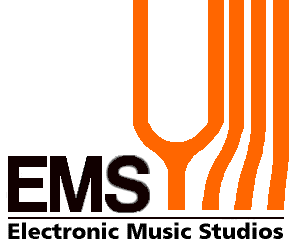
EMS: The Inside Story
by Graham HintonLast updated: 27th December 2002

Last updated: 27th December 2002
Electronic Music Studios (London) Ltd. was formed in 1969 by Dr. Peter Zinovieff to market innovative ideas arising from his private studio and interest in musical applications of computers. Over the next ten years many seminal products were released and many talented designers worked for the company. EMS had its own peculiar brand of British eccentricity which could be both endearing and annoying, but should be viewed in the context of true pioneering. It is easy to copy and follow others, but not to think up new ideas in the first place and EMS had no shortage of originality. The EMS influence was significant and can be traced into many contemporary products.
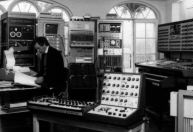 Peter Zinovieff in EMS Putney Studio (GIF = 195K)
Peter Zinovieff in EMS Putney Studio (GIF = 195K)
It may be difficult for a generation brought up with 32-bit computers and digital signal processors as consumer items to appreciate just how revolutionary Peter Zinovieff's projects were. In the 1960s to have access to a 12-bit computer with 1K of memory outside the academic or military establishment, let alone have two personal ones and then use them for music, was completely unheard of. To have a video screen as well when most people programmed with punched cards was beyond belief. Today there is a huge worldwide market for electronic music equipment, but there is little that was not envisioned by the EMS team before 1970 ten to twenty years ahead of their time.
The demise of EMS has many parallels with that of ARP. Both companies succumbed to the lure of the guitar market, ARP with the Avatar and EMS with the Hi-Fli. Both put a large amount of R&D effort into ambitious projects that were never completed. Had they both stayed within the markets they excelled in history could be quite different. After gearing up to make large quantities of the Hi-Fli, for which there was not actually a corresponding demand, EMS incurred burdening debts. Diversification with the International Voice Movement and falling victims to a financial fraud made the collapse of EMS in 1979 inevitable.
Interest in EMS and particularly the VCS3 has now reached cult proportions and its products have become rare collectors items. The fact that VCS3s exchange hands for up to £2000 while a DX7 is lucky to scrape £250 is testimony to how they are appreciated. Unfortunately there is much misinformation and many inaccurate websites and press articles, even when they plagiarise this site without due credit they still cannot get the facts right. This page is intended to provide a definitive record and insight by people who were actually there.
Like many companies, only 10% of the R&D turns into products and only 10% of those do well. EMS is best known for its VCS3/Synthi A synthesizers, but that was just the tip of the iceberg.
A lot of the EMS research effort went into developing unique devices used in Peter Zinovieff's private studio. Even before EMS was formed as a company, David Cockerell had produced a minicomputer controllable 60-channel analogue filter/oscillator bank. In other words the entire studio was a computerised vocoder and this was further developed as a fully digital version in the early 1970s. Some of this research surfaced as later products such as the Vocoders and Sequencers, but most remained embodied in several unique devices:
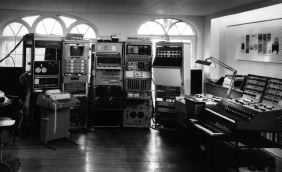 EMS Putney Studio (GIF = 361K)
EMS Putney Studio (GIF = 361K)
Some more details of the computers in this studio and a colour picture appear on Peter Grogono's Website
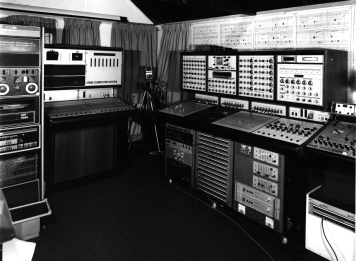 The last version of Peter Zinovieff's Studio in Oxfordshire (GIF = 542KB)
The last version of Peter Zinovieff's Studio in Oxfordshire (GIF = 542KB)
For more information about PDP8 computers see Online PDP-8 Main Page
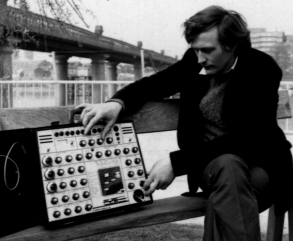
Peter Zinovieff (Chairman: 1969 - 1979)
The founder, driving force and person synomynous with EMS. Pioneer of using
mini-computers for musical applications during the 1960s. Now retired.
Tristram Cary (Director: 1969 - 1973)
Pioneer of classical electronic music during 1960s and composer for film and
broadcast with musical credits on the first Dr.Who & the Daleks and several
Hammer films. Left to become Professor of Electronic Music at the Royal College
of Music. Since became Professor of Music at the University of Adelade. Now
retired.
David Cockerell (Analogue/Digital design: 1969 - 1972)
Left to join Electro-Harmonix and designed most of their pedals. Went to IRCAM
in 1976 for six months, but returned to Electro-Harmonix again. Has designed
the entire Akai sampler range to date, some in collaboration with Chris Huggett
(the Wasp & OSCar designer) and Tim Orr.
Robin Wood (Sales/Demonstrator: 1970 - present)
Still flying the flag, see below.
Alan Sutcliffe (Software: 1969 - 1979)
Wrote the computer graphics for planet contours used in "Alien".
Peter Grogono (Software: 1969 - 1973)
Worked on the MUSYS programming language and further developed it into the Mouse language. Now teaching in Canada.
Jim Lawson (Software: 1973 - 1976)
Worked on the MUSYS programming language. Left to join IRCAM. Later LucasFilms.
John Holbrook (Studio assistant/sales demonstrator: 1971 - 72)
Has been living in the USA since 1973, & continues to work in music as an
engineer/producer/musician.
Graham Wood (Service Manager: 1971 - 1977)
Peter Eastty (Digital design: 1972 - 1977)
Left to join IRCAM. Now a consultant at Sony Broadcast.
Richard Monkhouse (Digital & Video design:1972 - 1975)
Freelance design consultant often collaborating with other ex-EMS designers.
Never credited for many designs including the Sycologic M16 and the SoundBeam.
Interviewed about Spectron
Now developing Photovoltaics.
Tim Orr (Analogue design: 1972 - 1977)
Prolific designer. Many of the Powertran Synthesizer kits were designed by him
with Richard Monkhouse. Lectured at London College of Furniture.
Now working as a design consultant.
Graham Hinton (Analogue/Digital design:1978 -1979)
Left to join Research Machines and designed their LAN. Has since designed products for
HH, Amek and Solid State Logic.
Now running Hinton Instruments
producing custom synthesis and pro audio equipment and actively involved with live recording and engineering.
The BBC Radiophonic Workshop
There are several good sites about the Radiophonic Workshop:
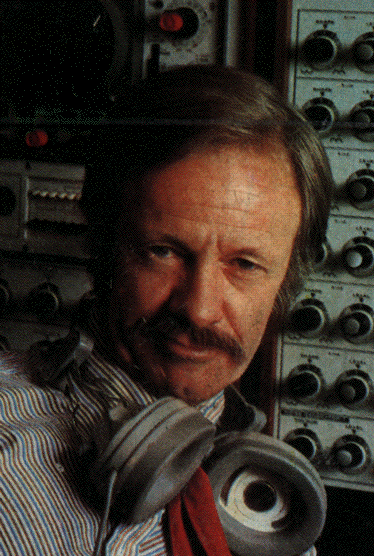
Also of interest is Mark Ayers Dr Who Pages which discusses the soundtrack production in detail.
The BBC have released the following CDs featuring electronic compositions realised by the Radiophonic Workshop:

Doctor Who at the BBC Radiophonic Workshop Volume 1 - The Early Years (1963-1969)
Doctor Who at the BBC Radiophonic Workshop Volume 2 - New Beginnings (1970-1980)
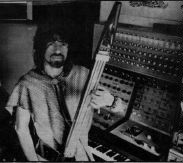
Pink Floyd - Meddle, Obscured by Clouds,
Dark Side of the Moon, Animals, Wish You Were Here

Pink Floyd at Abbey Road Studios
Brian Eno/Roxy Music
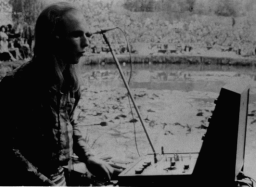
Roxy Music performing at the Crystal Palace Bowl
This VCS3 has recently been purchased by David Bowie for an astronomical sum!
Malcolm Cecil/TONTO - Zero Time, It's About Time
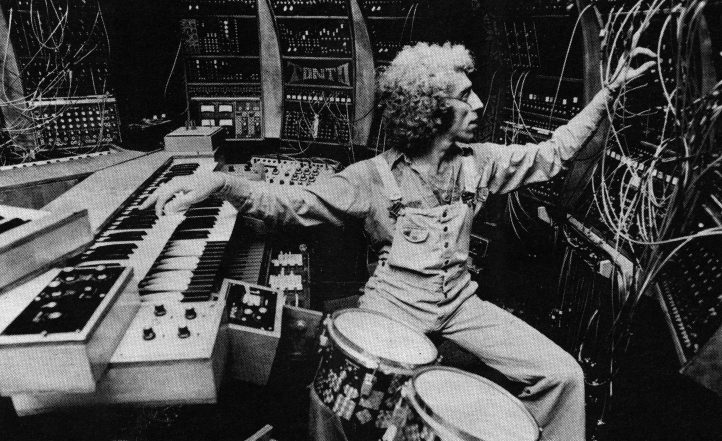
There is a Sequencer 256 in there somewhere
Tim Blake*/Gong -Flying Teapot, Angel's Egg, You
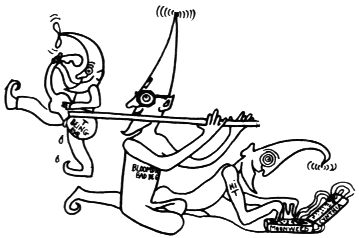
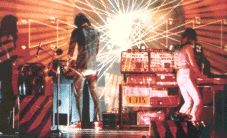
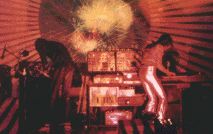
Basil Brooks (Synthi AKS) & Tim Blake (2 x Synthi AKS + Minimoog) circa 1976
Lightshow: Acidica by John Andrews
Zorch*
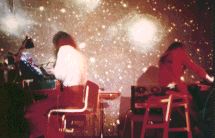
Basil Brooks (2 x Synthi AKS & Hi-Fli) & Gwyo Zepix (Synthi A + DK2) circa 1976
 An archive CD of material recorded in the EMS Putney Studio in 1975,
OUROBOROS, has now been released.
An archive CD of material recorded in the EMS Putney Studio in 1975,
OUROBOROS, has now been released.
 Zorch are still performing live with a Synthi A in use since 1972.
Glastonbury ~ Live recorded May 2001.
Zorch are still performing live with a Synthi A in use since 1972.
Glastonbury ~ Live recorded May 2001.
* The most serious users developed several modifications to their instruments which dramatically increased the capabilities. Do not imagine that by aquiring a standard production model that their sounds can be emulated. Full information of VCS3/Synthi A modifications are detailed on a separate EMS Modifications Page.
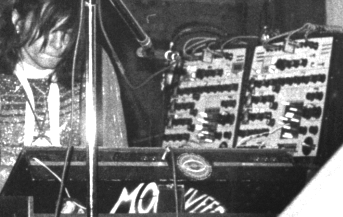
After EMS(London) folded in 1979 the assets were bought by Datanomics, a company that made rocking hospital beds [sic.]. From 1980 to 1984 a small number of VCS3s, Synthi AKSs and Vocoders were made and a new synthesizer was developed, the DataSynthi. This was essentially a VCS3 type monophonic keyboard using Curtis ICs with a programmable patch matrix and it was never produced. They also redesigned all the circuitry of the Synthi 100 and then sold just one to a studio in Spain.
After the honeymoon, Datanomics realised that they were not destined to become commercial synthesizer manufacturers and EMS was sold again. The next owner was composer Edward Williams, a long term EMS user and enthusiast, with the soundtracks of the famous "Life on Earth" documentary series to his credit. The Soundbeam and several upgrades to the Vocoders were made during this period.
In April 1995 Robin Wood aquired the full rights of EMS after working for all incarnations continuously since 1970. Synthi As, VCS3s and Vocoders are still being produced to the original or modified specifications. Current details and news appears in the EMS Main Page.
![]() Go to EMS Product Guide Page
Go to EMS Product Guide Page
![]() Go to EMS Modifications Page
Go to EMS Modifications Page
All material on these pages Copyright ©1995 - 2002 Graham Hinton.
except:
Dudley Simpson and BBC CD covers ©1973 BBC
Other colour photographs ©1976 John Andrews Digital Arts)
Synthi is a trademark of Electronic Music Studios.
All manufacturers' trademarks are acknowledged.